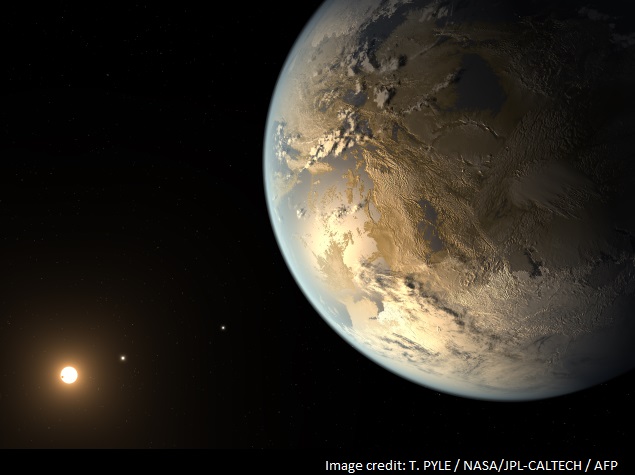- Home
- Science
- Science News
- First Earth sized planet found in 'habitable zone': NASA
First Earth-sized planet found in 'habitable zone': NASA

The exoplanet dubbed Kepler-186f was first spotted by scientists using Nasa's Kepler telescope, according to research published Thursday in the US journal Science.
The exoplanet, located some 500 light years from Earth, orbits in what is seen as the sweet spot around its star: not too close and not too far, so it could have liquid water, considered a crucial component to possibly hosting life.
"The discovery of Kepler-186f is a significant step toward finding worlds like our planet Earth," said Paul Hertz, Nasa's Astrophysics Division director at the agency's headquarters in Washington.
"What makes this finding particularly compelling is that this Earth-sized planet, one of five orbiting this star, which is cooler than the Sun, resides in a temperate region where water could exist in liquid form," said Elisa Quintana of the SETI Institute at Nasa's Ames Research Center in California, the lead author of the paper published in Science.
Kepler-186f is around 1.1-times the size of Earth which researchers say is key to predicting the composition of the surface and its atmosphere.
When planets are 1.5 times the size of Earth or larger, many of them seem to attract a thick hydrogen and helium layer that makes them start to resemble gas giants like Jupiter or Saturn.
Kepler-186f is the fifth and outermost planet orbiting the Kepler-186 star, right on the far edge of that solar system's habitable zone, meaning the surface temperature might not be warm enough to stop water from freezing.
"However, it is also slightly larger than the Earth, and so the hope would be that this would result in a thicker atmosphere that would provide extra insulation," explained San Francisco State University astronomer Stephen Kane, another member of the team behind the discovery.
Tracking 'transits'
Scientists using the Nasa's Kepler telescope first discovered it by tracking "transits" shadows that cross in front of the star.
The finding was confirmed by observations from the W.M. Keck and Gemini Observatories.
"The discovery of planets with Earth-like properties is one important link in the chain required to answer" whether life can exist on other planets, said co-author Fred Adams, an astronomer at the University of Michigan.
"And the discovery of the planet Kepler-186f is an important step toward finding a planet that is like our Earth," he added.
But current technology does not allow astronomers to see the celestial body directly or do any analysis to determine its atmosphere or composition.
"Some people call these habitable planets, which of course we have no idea if they are," said Kane. "We simply know that they are in the habitable zone, and that is the best place to start looking for habitable planets."
Because its star is so dim, Kepler-186f may not be suitable for follow-up studies to determine its composition, explained Quintana.
"However, our research tells us that we should be able to find planets around bright stars that will be ideal targets to observe" with telescopes like Nasa's Webb orbiting telescope, currently under construction, she said.
Of nearly 1,800 planets detected over the past 20 years, only around 20 orbit within the so-called "habitable zone" and all appear to be larger than Earth, which makes it harder to tell whether or not they are gas giants.
The Kepler space telescope, launched in March 2009, observes some 150,000 stars, a few thousand of which have been found to have possible planets.
For the latest tech news and reviews, follow Gadgets 360 on X, Facebook, WhatsApp, Threads and Google News. For the latest videos on gadgets and tech, subscribe to our YouTube channel. If you want to know everything about top influencers, follow our in-house Who'sThat360 on Instagram and YouTube.
- Samsung Galaxy Unpacked 2025
- ChatGPT
- Redmi Note 14 Pro+
- iPhone 16
- Apple Vision Pro
- Oneplus 12
- OnePlus Nord CE 3 Lite 5G
- iPhone 13
- Xiaomi 14 Pro
- Oppo Find N3
- Tecno Spark Go (2023)
- Realme V30
- Best Phones Under 25000
- Samsung Galaxy S24 Series
- Cryptocurrency
- iQoo 12
- Samsung Galaxy S24 Ultra
- Giottus
- Samsung Galaxy Z Flip 5
- Apple 'Scary Fast'
- Housefull 5
- GoPro Hero 12 Black Review
- Invincible Season 2
- JioGlass
- HD Ready TV
- Laptop Under 50000
- Smartwatch Under 10000
- Latest Mobile Phones
- Compare Phones
- Redmi Turbo 4
- Vivo Y200+
- Lava Yuva 2 5G
- OnePlus Ace 5
- OnePlus Ace 5 Pro
- Oppo A5 Pro 5G
- Vivo Y29 5G
- Honor Magic 7 RSR Porsche Design
- Asus Zenbook S 14
- MacBook Pro 16-inch (M4 Max, 2024)
- Honor Pad X9 Pro
- Honor Pad V9
- boAt Enigma Gem
- boAt Enigma Daze
- Sony 65 Inches Ultra HD (4K) LED Smart TV (KD-65X74L)
- TCL 55 Inches Ultra HD (4K) LED Smart TV (55C61B)
- Sony PlayStation 5 Pro
- Sony PlayStation 5 Slim Digital Edition
- Blue Star 1.5 Ton 3 Star Inverter Split AC (IC318DNUHC)
- Blue Star 1.5 Ton 3 Star Inverter Split AC (IA318VKU)












